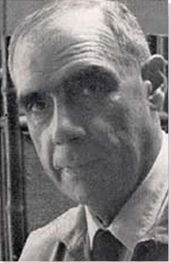Summary of Henri Laurens
Laurens indulged in a wide range of artistic practices but is most readily associated with the pre-war Cubists. After the war, he would come to see the movement's focus on geometric planes as too dogmatic and his body of work acceded more and more the formal and thematic influences of Classical sculpture. He would move away from the sharp-edged fragmentation of Cubism to experiment with more organic, curved shapes which he matched to mythical subject matter. This initiative can be seen historically as part of a wider post-war project to bring about societal stability through a more accessible aesthetic approach. His curved forms, which were an extension of, rather than a rupture with, high modernism, fitted with the artist's radical politics which he believed would be better served by a less-aggressive, more agreeable, form of avant-gardism.
Accomplishments
- Laurens's papier collé works saw him linked to fellow Cubists Picasso, Braque and Juan Gris. Laurens, however, synthesized their ideas by applying a coloristic and sculptural dimension to his collages. Like his colleagues, Laurens experimented with overlapping planes and formal fragmentation, but he employed color, not as an independent picture entity, by rather as a means of stressing the three-dimensionality of his collage.
- Moving into the inter-war years - the period that became known as the "new order" - Laurens's sculptures reduced in their geometric complexity, becoming less fragmented and more unified. What became known as Interwar Classicism challenged the belief that modern art was all about progress and innovation. Though many modernists came to be view it as mere nostalgia, some artists, including Laurens, sought to bring elements of classicism and modernism into a new relationship. His female busts, for instance, do not conceal their debt to African masks or the female faces of his friend Amedeo Modigliani, but they are unique in terms of their kinship with archaic Cycladic sculptures.
- Laurens's interest in curvilinear Cycladic sculpture extended to full-bodied works such as those representing Venus, the Grecian goddess of love. His sculptures were nothing short of radical reinventions; effectively turning the archaic model "inside-out" by featuring (rather than concealing) the stone mass from which the figure was sculpted.
- Laurens illustrated numerous texts and books of poetry. His illustrations, including woodcuts of reclining nudes, carried the influence of Henri Matisse's "cut-outs" and Pablo Picasso's continuous line drawings, but his "liquid" curvilinear bodies owed just as much to the Surrealist technique of automatic drawing and the curved planes of Joan Miró and Hans Arp. His illustrations brought further confirmation that Laurens was an artist who was almost impossible to pigeon-hole.
Important Art by Henri Laurens
Head of a Woman
In Head of a Woman, Laurens demonstrates what is meant by "sculpto-painting", a term used by author and museum director A.M. Hammacher to describe this work and to place Laurens alongside the likes of Cubist sculptor Alexander Archipenko. Laurens's piece made tangible the Analytic Cubist technique of fracturing three-dimensional forms onto a two-dimensional canvas. The artist here flattened composite views of the woman's head as seen from various angles and at various times of day, and used jagged triangular, rectilinear, and curved shapes to indicate the co-presence of these diverse perceptual experiences. Yet, unlike Cubist paintings, Laurens literally worked in three-dimensions with his non-natural sculptural planes translating the impossible experience of simultaneous vision into an actual spatial representation.
The artist also used paint strategically. Reversing aerial perspective, which would relegate darkened colors to the more distant background with lighter, brighter, more visible spaces in the foreground, Laurens painted the back recesses of the woman's eye areas light brown, with black-painted planes composing the contours of her face. White-painted accent triangles suggested the outlines of the woman's nose, and, in another reverse of chiaroscuro, the shadowed recesses of her neck.
Painted wood construction - The Museum of Modern Art, New York
L'Instrument de Musique (The Musical Instrument)
Laurens's Cubist collages and papier collé works closely aligned with the methods and themes of his fellow Cubists, such as Pablo Picasso. Like Picasso, Laurens used Cubist compositional techniques on a narrow range of themes, such as still lifes - in this case, a guitar. Laurens deconstructed the guitar into planar units with overlaid chalk and charcoal drawings indicating the guitar sound hole, strings, outline, as well as its frets. The artist also integrated text with his collage, including the word "musique" as a means to signify auditory experience unable to be captured through visual media.
Unique to Laurens, however, was his maintenance of a coloristic and sculptural sensibility in his collages. Here, the artist played with overlapping black and white planes which at once suggested standard Cubist formal fragmentation, but at the same time reduced chiaroscuro to planar units of light and shade. Color, or, in this case, value, did as much of the compositional "heavy lifting" to suggest three-dimensionality as the tangible pasted papers.
Collage with charcoal and white chalk on brown paperboard - The National Gallery of Art, Washington DC
Woman with a Mandolin
The subject of a woman with a mandolin was a common theme amongst Cubist painters and sculptors. Here, Laurens's sculpture (like Picasso's 1910 Girl with a Mandolin) used a combination of sharp and curved planar units to blur the boundaries between the female subject and the instrument she played.
Woman with a Mandolin in particular invites comparison with works by another notable Cubist sculptor, Jacques Lipchitz. Like Laurens, Lipchitz, in works such as his 1920 Seated Man with Clarinet I literalized the Cubist dissolution of perspectival illusionism, creating layers of angular, geometric forms which suggested the simultaneity of foreground and background space. Yet, unlike Lipchitz's work, Laurens's Woman with a Mandolin is as a more organic (less fragmented) sculpture. Here planar angles build from the ground to an apex with a tapered, bent head, rather than progressed outward as a deliberately sharp sculptural articulation of front and back planes.
Anticipating the curved female forms of his later career, Laurens rendered this woman as almost a fluid, organic outgrowth of the earthenware; with the barest suggestion of hair, head, eyes, and arms. Despite the compositional fragmentation, the woman appeared to emerge naturally from within the material.
Unglazed cast earthenware - Smart Museum of Art, University of Chicago
Tête de jeune fillette (Head of a Young Girl)
Laurens's various iterations of female heads during the 1920s are reminiscent of similar heads by Constantin Brancusi, as they, like Brancusi's sculptures, appear as smooth, organic, and abstracted mutations of the compositional materials themselves. Like Brancusi, and the works of Laurens's friend, Amedeo Modigliani, the artist turned to non-Western sources for inspiration, notably African masks. Laurens composed his bust with features akin to Modigliani's female faces, which were characterized by elongated noses, almond eyes, and tiny bud lips. In works such as Head of a Young Girl, Laurens also indicated his affinity for archaic sculptures, such as the sharp angularity of Cycladic figures or ancient Mesopotamian pieces. Laurens, in fact, described Cycladic sculpture as leading "nowhere" and yet containing "everything".
The artist softened the complexity of Cubist fractured planes, reducing his representation to a few simple geometric shapes and an interplay between the curved forms of the base and oval shape of the head, and the sharp, triangular planes which comprised her face. Laurens translated the Cubist project of simultaneous vision to this sculpture, where each facet of the young girl's face adds detail to her appearance. For instance, whereas the left facial plane provides outlines of her facial features and ear, the right facial plane introduces abstracted linear waves to suggest her flowing hair, and a deeply carved line to outline the girl's eyelid.
Limestone - Collection of the Tate, United Kingdom
Tête de boxeur (Head of a Boxer)
Here Laurens's boxer emerges firstly as a low-relief black plane that passes through a further three painted - yellow, pink, white - surfaces. The Tate gallery attributes this work's inspiration to Laurens's Cubist collage more than his sculptural practice. The Tate also records that the paint application results in "geometric areas with no tonal gradation," a decision which "emphasizes the similarity between these shallow planes and the cut-out and superimposed elements of a collage". Laurens's planar units, distinguished from one another by unmodulated color blocks, additionally work to indicate a "play between flatness and volume," caused by the "effects of light and shade falling across the difference levels of the surface".
The influence of collage can also be detected in Laurens's play with texture. Rather than simply experiment with the representation of depth through varying levels of relief, the artist depicted the most recessed black plane with horizontal bands, creating ridges. In this manner, Laurens replicated the interplay of textures typical of Cubist collage through the terracotta medium alone.
Painted terracotta - Collection of the Tate, United Kingdom
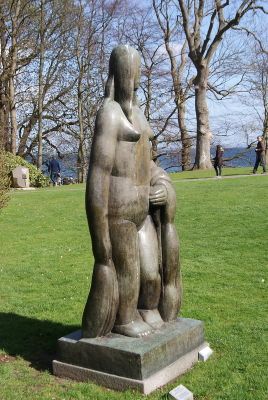
Woman with Drapery
Woman with Drapery showcases both Laurens's return to curvilinear forms and his interest in Classical themes. This piece reinterprets the caryatid goddess, or the Classical nude Venus, in an avant-garde idiom. Like its Classical form, Laurens's woman, who appears with a slight contrapposto, has flowing locks and holds her discarded Grecian garment. Yet whereas the sculptors of Classical caryatids aimed to conceal the stone mass beneath the softness and delicacy of the female form, Laurens chose to reverse this dynamic.
His Woman with Drapery constitutes an almost amorphous, solid figure, with her breasts, face, and limbs barely distinguishable. Though she bends one knee in contrapposto, the implication of motion doesn't deny the sculpture's weight, but rather reinforces it through the knee's roughly planar segments, and the thick, heavy foot. As with many of his works, Laurens juxtaposed perceptions of mass; despite the thick, block-like appearance of the sculpture, the work tapers upwards to a thin, elegant head with flowing hair.
Bronze - The Museum of Modern Art, New York
La petite sirène (The Little Siren)
As part of a series of siren sculptures inspired by his trip to the Brittany coast, Laurens depicted the treacherous mythological woman as if an extension of the sea from which she came, and of the rocks upon which she lured unsuspecting sailors. A continuous form, her body begins as an undulating curve, which develops into a stone, and then upwards like a swelling wave to her torso.
The artist uses an interplay between sinuous curling lines and pointed, jagged forms to illustrate the threat of the siren. Like the sailor, the siren's body begins with a beautiful song, her torso an organic curve as if born from the waves. Yet, moving upward, Laurens depicted her breasts, outstretched arms, and head as jagged, sharp points jutting out into space. Just as the siren's body transitions from swelling waves to threatening daggers, the sailor's attraction leads to his deadly end, when the distraction of the siren's call causes his ship to crash upon the rocks.
Bronze - Mildred Lane Kemper Art Museum, St. Louis
Reclining Woman
Laurens's artistic production was prolific, and he illustrated many texts and books of poetry over his lifetime. In this example, the artist translated his curvilinear reclining female nude sculptures to woodcut. Like his sculptural work, Laurens reduced the female form to a sinuous, organic shape, with curves and rounded forms suggesting a body more liquid than material.
Yet, here in an image from Un Poème dans chaque livre by Paul Élouard, Laurens also indicated the fruits of his friendship with Surrealist artists, as well as his continuing fascination with Picasso and his admiration for Henri Matisse. The Reclining Woman suggests Picasso's continuous line drawings or Matisse's cut-outs or dancers, as the contours of the woman's body appear to have neither a beginning nor an end. Indeed, the "eye-hole" at the head of the figure is the only independent mark on the figure.
In addition, this work is akin to a Surrealist automatic drawing, the curved planes of Joan Miró and Jean Arp, or Picasso's Surrealist bathers, their legs, breasts, and heads fragmented, continuous, and hollowed-out planes. Unlike Picasso's seemingly skeletal bathers, however, Laurens removed the menace implied through Picasso's nude women's sharp, bared teeth. Laurens' Reclining Woman is rather a fluidly rendered, reclining Venus meant to be seen and admired, her head back and eye closed in ecstasy.
Woodcut - The Museum of Modern Art, New York
Biography of Henri Laurens
Childhood
Laurens was born in Paris in 1885, growing up in the suburb of Saint-Denis. The artist's father, Joseph, was a cooper, and his mother, to whom Henri was devoted, was the daughter of a sailor. The Laurens family had fled poverty in rural France for the possibilities of a better life in the city. However, despite his family's desire for social and personal betterment, Laurens' life would come to be defined as one of constant poverty, even after his late-career fame. The dealer Daniel-Henry Kahnweiler described Laurens' life as "simple and dignified" albeit one of greatly "modest circumstances" to match his "modest" but "great" temperament.
Laurens decided on an artistic career early in his life. To commemorate the hundredth anniversary of the French Revolution, the new French Republic erected sculptural monuments, such as Jules Dalou's Le triomphe de la République (1879-89) in the Place de la Nation. Laurens, along with his family and other working-class families in Paris, would visit the sculpture sites to watch the artists assemble and, in some cases, directly carve the monuments. The experience of watching the physical creation of these public sculptures instilled in the young Henri the desire to become a sculptor himself.
Early Training and Work
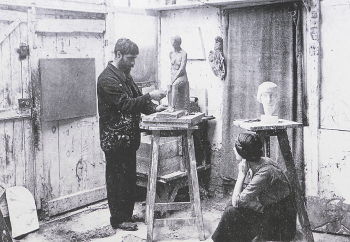
Between 1899 and 1902, Laurens attended the École d'Art Industriel Bernard Palissy in Paris to study decorative and ornamental sculpture. While working as a mason's apprentice at Parisian building sites, the artist concurrently took evening classes in drawing with the sculptor Jacques Perrin.
At 17, Laurens moved to the Montmartre artistic district in Paris. Here, he worked as a stonemason and also befriended individuals like Paco Durrio, who had been a friend to Paul Gauguin and an early mentor to Pablo Picasso. Through Durrio, Laurens initiated his contact with the Spanish avant-garde residing in Paris. Laurens's early sculptural works were inspired by Auguste Rodin, though he worked hard to refine his own aesthetic approach. In 1908, Laurens married Marthe Duverger, who was also an artist. An admirer of Georges Braque, Marthe later created Cubist-inspired still lifes and became a respected ceramicist.
In 1902, Laurens began to display the first symptoms of bone tuberculosis, an affliction that would persist for the remainder of his life, and would result in the amputation of his left leg in 1909. Kahnweiler, in his recollections of Laurens's life, noted that the artist was "often in pain" as a result of his bone disease. Laurens himself never complained, however, and the dealer described him as a "brave man".
Mature Period
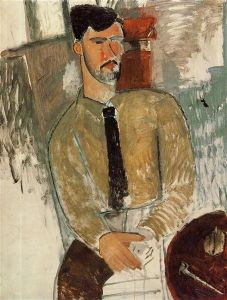
Around 1911, the artist's professional trajectory dramatically shifted when he met Braque, whose wife was Marthe's childhood acquaintance. Through Braque (the two men would become life-long friends), the artist was introduced to Juan Gris, Picasso, and their experimental methods. Laurens had maintained a relatively solitary practice prior up to this point. But after his new associations, he became more closely involved with the Parisian avant-garde and dedicated himself to the study of Cubism. In 1912, Laurens made his first Cubist sculptures in terracotta, and then, around 1915, his first collages. Laurens's collages, like those of Picasso and Braque, embraced non-traditional materials and ephemera, including rusty sheet metal, wood boards, and plaster.
At the outbreak of World War One, Laurens's handicap curtailed any military participation and he spent the duration of the conflict increasing his profile through his Cubist experiments and his practice became steadily more diverse. By 1918 he was working on freestanding Cubist sculptures; Cubist reliefs and assemblages; illustrated works of poetry; and engaged in interdisciplinary exchanges with writers of the avant-garde Nord-Sud magazine and the Groupe des Six musicians circle. Indeed, in his interactions with Laurens, photographer Brassaï described the artist's work as "plastic lyricism" which was consistent with the artist's love for music and its powers of inspiration. In what would become a hallmark of his varied practice, Laurens also designed sets for the Ballets Russes and other theatrical productions, and created Cubist-inspired decorative arts pieces.
By 1919, Laurens had returned to sculpture in the round, according to scholar Isabelle Monod-Fontaine, where he used direct carvings or bronze castings to create works unified in a rhythmic "dense core" which was "broken but not divided by Cubist angles and planes". Laurens' practice began to shift to stone, terracotta, and wood reliefs in lieu of Cubist sculptures, and in the 1920s he produced terracotta as well as small bronze sculptures. Laurens preferred to let his works speak for themselves, and never indulged in extended expositions.
Laurens signed contracts and exhibited with the Cubist dealer Léonce Rosenberg, both in solo shows, and as part of Cubist and avant-garde exhibitions alongside Picasso, Braque, Gris, Fernand Léger, and Piet Mondrian. In 1920, Laurens confirmed his affiliation with the Cubist elite when he signed a contract with Picasso and Braque's champion, the dealer Daniel-Henry Kahnweiler. However, Laurens declined to renew his contract with Kahnweiler after its expiration, preferring to work henceforward with collectors and other creative collaborators directly.
Late Period
In the interwar years, Laurens befriended and socialized with advocates of figuration and Surrealism, such as Jean Cocteau and Michel Leiris. By 1925, his practice shifted away from a strict Cubist aesthetic and he began producing, according to the Museum Beelden aan Zee catalogue for the artist's retrospective exhibition, "voluminous representation[s] of the human figure". It was a period in art history that gave rise to Interwar Classicism; a style that looked to the past when abstraction was seen (by some) as self-indulgent. Laurens belonged to a group of artists who preferred to explore new combinations of classicism and modernity. Laurens's practice in his later years simplified form and subject, fixating often on classical nude female sculptures whose bodies the artist reduced to studies in voids and compact geometries.
Laurens's curved forms took their inspiration from nature. Marthe recalled that, while staying in the French countryside near Marly, the artist would take long walks through the forest and then create figures akin to knotted tree branches, with surface textures approximating bark. In 1937, he began his notable sculptural series of nude women, Sirènes, after visiting the Brittany seaside. His practice remained diverse, and he created traditional sculptural work, bronzes, carpet and fire screen designs (for the art collector, philanthropist, and cosmetics entrepreneur Helena Rubinstein), decorative fountains, lithographs, and text illustrations.
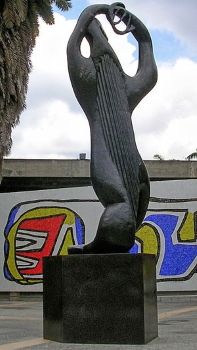
Politically, the artist was associated with anarchist and anti-Fascist ideology. In the lead up to World War Two, Laurens participated in any artistic event dedicated to the critique of Fascism, and, in response to the global upheaval, he created a work depicting the Greek demi-deity Amphion, who promoted peace through music. L'Amphion, made specifically for the new campus of the University of Caracas was completed shortly before his death (a copy of L'Amphion is held by the Dallas Museum of Art). Such was Laurens's commitment to the political cause, during the Nazi occupation of Paris, Laurens hid the Spanish Republican sculptor Baltasar Lobo in his home.
In 1938, Laurens's work began to be exhibited in America with a solo exhibition at the Brummer Gallery, and in 1939 Laurens was part of the famous Museum of Modern Art exhibition celebration of the avant-garde, Art in our Time. In 1950, he was, according to the Museum Beelden aan Zee, "ignored for the Grand Prix for Sculpture" at the Venice Biennale but "received from Matisse half of his Grand Prix for Painting as a gesture of sympathy". Laurens died on May 5, 1954, of a heart attack while out on a walk in Paris.
The Legacy of Henri Laurens
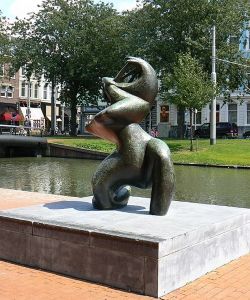
Laurens' influence on future artistic generations largely stems from his translation of Cubist planar fragmentation into three-dimensions, and his extension of the Cubist dissolution of space into more rounded, organic iterations. In addition, the artist's varied practice blurred boundaries among artistic mediums. Whether through his painted Cubist sculptures, where physical shapes and colorfully painted planes competed to suggest contour and depth, or through his literary illustrations, Laurens's oeuvre provided his successors with a model of artistic activity and diversity which transcended singular categorization.
Known as an ethical and honorable man, Laurens was one of the few artists who turned down the French Legion of Honor, citing political differences. According to art historian Mady Ménier, the Laurens family was never financially secure, as the artist only accepted those commissions "that interested him". Yet, Laurens's only financial regret was that his diminished income prevented him from creating a memorial tribute to his close friend, the poet Max Jacob, who had perished on the way to Auschwitz internment.
Influences and Connections

-
![Amedeo Modigliani]() Amedeo Modigliani
Amedeo Modigliani -
![Jacques Lipchitz]() Jacques Lipchitz
Jacques Lipchitz - Paco Durrio
- Paul Dermée
- Léonce Rosenberg
-
![Henry Moore]() Henry Moore
Henry Moore -
![Henri Matisse]() Henri Matisse
Henri Matisse -
![Leonard Baskin]() Leonard Baskin
Leonard Baskin - Baltasar Lobo
- Marta Colvin Andrade
-
![Jean Cocteau]() Jean Cocteau
Jean Cocteau -
![Amedeo Modigliani]() Amedeo Modigliani
Amedeo Modigliani -
![Juan Gris]() Juan Gris
Juan Gris ![Michel Leiris]() Michel Leiris
Michel Leiris
-
![Interwar Classicism]() Interwar Classicism
Interwar Classicism ![Modern Sculpture]() Modern Sculpture
Modern Sculpture
 Ask The Art Story AI
Ask The Art Story AI